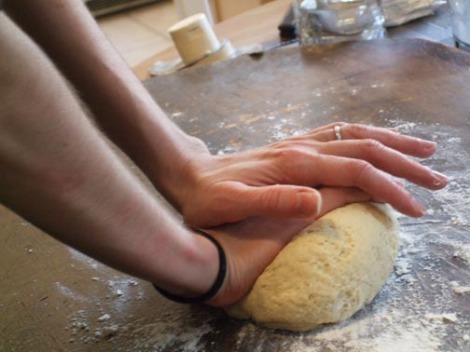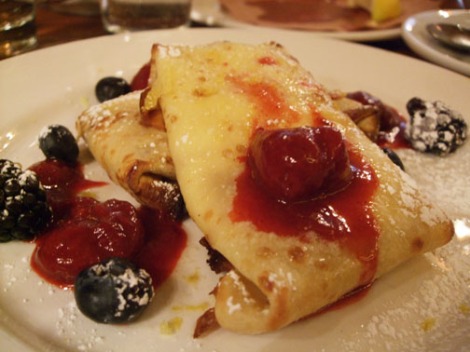Three years ago, my inaugural post on this blog was about making fresh pasta. Jim and I had pulled our never-used pasta machine out from storage, mixed together an egg-based dough, and cranked out an overwhelming quantity of linguine for the first time. Despite this successful experience—and apart from two other tiring experiments with homemade ravioli and ricotta gnocchi—making fresh pasta never became a habit for us. But on Sunday I was feeling adventurous and energized, and decided to try my hand at it again, this time with orecchiette.
Orecchiette means “little ears” in Italian. Small and circular with an indented center (hence the name), they are typical of the Southern region of Puglia, the area where my mother is from. Puglia’s flat landscape and arid temperatures are ideal for wheat production, making pasta and bread the most substantial elements of the region’s cuisine.
One of the interesting things about orecchiette and other traditional pastas from Southern Italy (such as cavatelli and strozzapreti) is that the dough is often made without eggs—flour, water, and salt are the main ingredients. A mixture of semolina and white flour forms the base of what becomes a chewy, dense pasta that can stand up to the most aggressive sauces. I have to say, this is one of the easiest doughs I have ever worked with. The absence of eggs creates an elastic dough that is quickly kneaded into a smooth ball, ready for shaping.
The rest of the steps on Sunday were decidedly un-exhausting. I divided the dough into 8 equal pieces, rolling each one into a long rope. After cutting them into compact squares, I pushed my thumb in the middle of each piece and gently dragged them a short way across my pasta board, creating a series of concave disks. I’ll admit, my first few attempts looked more like Fritos corn chips than perfectly circular orecchiette, but these are supposed to be rustic, right? Eventually I got the hang of it, and before I knew it, two cookie sheets were full of orecchiette waiting to be cooked.

In order to keep with the Puglian theme, I used my homemade “ears” in one of the region’s iconic dishes: orecchiette with sausage and broccoli rabe. Because of their cup-like shape, orecchiette are rarely paired with smooth tomato- or cream-based sauces; chunkier sauces with meat or vegetables work better with this particular pasta. While the orecchiette cooked, I combined some blanched broccoli rabe with olive oil, garlic, and our favorite fennel sausage from our local pork store. Once tossed with these ingredients, the orecchiette formed a neutral, sturdy base for the bitter greens and strongly spiced meat, a classic combination that works every time. Now that I know how easy it is to make orecchiette, I see many more Puglian Sundays in our future. Cavatelli, here we come!
Recipe for Homemade Orecchiette with Fennel Sausage and Broccoli Rabe
For the pasta dough (recipe adapted from Michele Scicolone’s A Fresh Taste of Italy):
- 1-1/2 cups all-purpose flour
- 1 cup semolina flour
- 1 teaspoon salt
- 3/4 cup warm water
Combine the all-purpose and semolina flours and the salt in a food processor. With the machine running, slowly add the water, until a stiff ball of dough forms. Remove the dough from the processor and place it on a lightly floured surface. Knead the dough until it is smooth and elastic, about a minute or two.
Divide the dough into 8 equal pieces. Take one piece and keep the remaining pieces covered with the inverted food processor bowl or another bowl. Taking the dough between your hands, roll it into a long rope about 1/2-inch thick. Cut the rope into 1/2-inch pieces. With your thumb parallel to the long side of each piece, push it into the center of the dough and slightly drag the piece backwards. It will curl around your thumb, creating a concave disk. Set aside and repeat with the next piece of dough. When finished with all the dough, place the orecchiette on cookie sheets lined with napkins and a light dusting of flour. Cook right away or freeze. You should wind up with about a pound of pasta.
To freeze the pasta, place the filled cookie sheets in the freezer. Freeze until they are solid (about an hour or two) and then transfer the orecchiette to freezer-safe bags. They can be frozen for up to one month. When you are ready to use them, don’t defrost them. Add them directly to boiling, salted water and cook as usual.
For the Sauce:
- sea salt
- 1 bunch of broccoli rabe, washed with ends trimmed
- 4 links of high quality fennel sausage
- 1 tablespoon olive oil
- 1 clove of garlic, minced
- salt
- pepper
- pecorino romano or parmesan cheese
Preheat the broiler. Bring a large pot of water (big enough to hold the pasta) to a boil. Season with sea salt. Add the broccoli rabe and blanch for about 3 to 5 minutes. Using tongs, remove the rabe from the water and set aside. Chop roughly into smaller pieces. Do not drain the boiling water.
While the broccoli rabe is cooking, cook the sausages under the broiler for about 6 minutes, turning them after 3 minutes. Remove from the broiler and slice into 1/2-inch pieces. The pieces will probably still be a little pink in the middle.
Add the pasta to the boiling broccoli rabe water, and cook until al dente, about 10 to 13 minutes. While the pasta is cooking, heat the olive oil over medium heat in a large skillet. Add the garlic and sauté until soft, about 3 to 5 minutes. Do not let it brown. Add the sausage and the broccoli rabe to the pan, cooking until done, about 5 to 7 minutes. Drain the pasta when ready.
Toss the broccoli rabe and sausage with the cooked pasta. Add a glug of olive oil and season with salt and pepper. Spoon into bowls and sprinkle with pecorino romano or parmesan cheese. Serves 4. Enjoy!

















 Subscribe to the Choke
Subscribe to the Choke 
